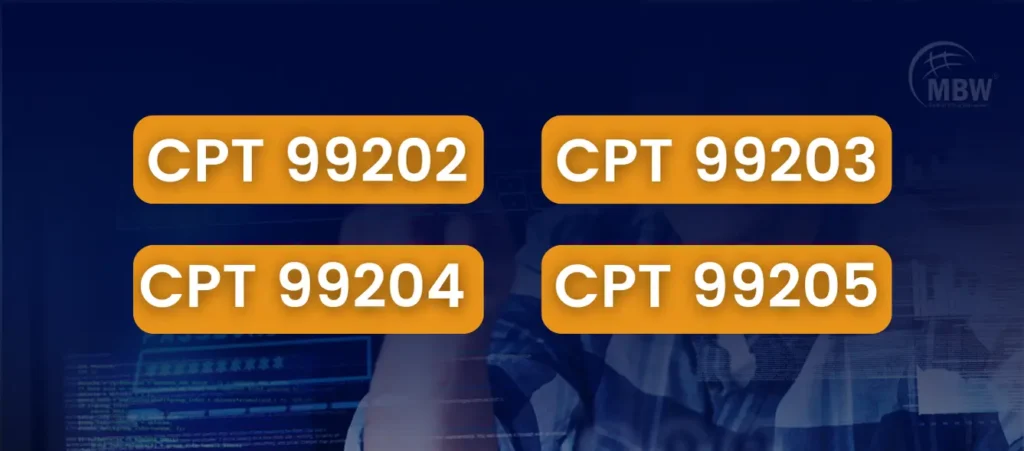Choosing the correct CPT code for new patient office visit isn’t just about billing—it’s about getting reimbursed accurately, avoiding denials, and staying audit-ready in 2025. New patient office visits are billed using CPT codes 99202 through 99205, depending on time or medical decision-making (MDM). In this comprehensive guide, you’ll find a breakdown of each code, real-world examples, and key documentation tips to avoid costly errors.
We’ll also explain the CPT code for new patient office visit 60 minutes, show the full office visit CPT codes list with time, and walk you through which ICD-10 code for new patient office visit to use. By the end, you’ll know how to confidently bill these encounters and protect your revenue.
Why CPT Coding Accuracy Matters in New Patient Visits
Using the wrong CPT code can result in underpayment, payer audits, or even penalties. Medical billing teams must understand when and how to use each new patient CPT code. New patient visits often involve more in-depth evaluations and longer consultations. That’s why CPT codes 99202 to 99205 exist—to reflect those differences.
Practices that miscode these visits may face delayed payments or payer pushback. In fact, many lose out on 7–11% of annual revenue due to improper coding.
To see how real providers fixed this, check out our case study on using the right CPT codes for prolonged services.
💬 “Choosing the wrong CPT code is like ordering a salad at a steakhouse—technically possible, but wildly unfulfilling.”
How Documentation Supports Proper Code Selection
Every CPT code for a new patient visit must be backed by strong documentation. Whether you choose the code based on MDM or time, you must document those factors explicitly.
For example, CPT 99205 (often used for 60-minute new patient visits) requires documentation of time spent counseling, coordinating care, and reviewing records—not just face-to-face time.
The more specific your charting, the easier it is to justify the level of service billed.
If you’re unsure how detailed your documentation should be, refer to HealthIT.gov’s guidelines for clinical documentation integrity.
Also, explore this deeper dive into understanding new patient CPT code usage for a step-by-step guide.
💬 “MDM stands for ‘Maybe Don’t Miscode’—if your notes are fuzzy, your payments will be too.”
New Patient CPT Code Office Visits Breakdown
Understanding each CPT code in the 99202–99205 range is essential. Here’s a detailed look at when to use each one:

CPT 99202
Straightforward Problems, 15–29 Minutes
Use 99202 when the provider handles a minor problem like a cold or skin rash. The MDM is straightforward, and total provider time is 15–29 minutes.
This code is ideal for low-acuity issues that don’t involve risk or complex evaluations. Though often used in urgent care settings, it still requires clear documentation.
CPT 99203
Low Complexity, 30–44 Minutes
99203 fits patients with slightly more complex problems, such as controlled hypertension or lifestyle-related fatigue. This visit usually includes an expanded history and low-complexity decision-making. Total time spent: 30–44 minutes. This is one of the most commonly billed codes in internal medicine but often under-documented.
CPT 99204
Moderate Complexity, 45–59 Minutes
Select 99204 for patients with moderate-risk conditions like uncontrolled diabetes or anxiety.
These visits require more in-depth evaluation, patient counseling, and sometimes referrals.
Time requirement: 45–59 minutes. This code is often flagged during audits due to insufficient documentation of MDM.
CPT 99205
High Complexity or 60-Minute Visits
99205 is the highest-level CPT code for new patient visits. It’s used when the encounter involves 60–74 minutes or high-complexity MDM.
Examples: Newly diagnosed cancer, major depression with suicidal ideation, or chronic illnesses requiring complex coordination.
This is also the primary CPT code for new patient office visit 60 minutes, making documentation absolutely critical.
“If you’re billing 99205 but your chart looks like a sticky note—expect a sticky situation with payers.”
Office Visit CPT Codes List with Time – New Patients
| CPT Code | Time (Minutes) | Decision-Making Level | Example Use Case |
|---|---|---|---|
| 99202 | 15–29 | Straightforward | Cold, sore throat |
| 99203 | 30–44 | Low | Hypertension, sleep issues |
| 99204 | 45–59 | Moderate | Depression, asthma |
| 99205 | 60–74 | High | Cancer, complex mental health eval |
These time-based guidelines are based on 2021 E/M updates by the AMA and remain critical as audits become more data-driven. According to a 2024 Medscape report, over 36% of practices still miscode new patient visits due to confusion between MDM and time-based billing.
Understanding this CPT time table supports correct revenue capture and protects practices from avoidable post-payment reviews.
Need more examples? Visit our New Patient CPT Codes Guide.
ICD-10 Code for New Patient Office Visit
Every CPT code must be paired with an appropriate ICD-10 code for new patient office visit. Here are some common examples:
Z00.00 – General adult checkup, no abnormal findings
Z00.01 – General adult checkup, abnormal findings
Z01.10 – Hearing exam without abnormal findings
Z71.1 – Patient counseling
Z76.89 – Other specified encounters
Pairing the right diagnosis with the correct CPT code is essential for claims to be accepted.
The CMS ICD-10 Guidelines offer full, official reference for billing specialists.
CPT Code for Office Visit Established Patient
| CPT Code | Time (Minutes) | MDM Level | Example |
|---|---|---|---|
| 99211 | <5 | None | Nurse vitals check |
| 99212 | 10–19 | Straightforward | Medication refill |
| 99213 | 20–29 | Low | Lab review, chronic disease mgmt |
| 99214 | 30–39 | Moderate | Diabetes follow-up, treatment change |
| 99215 | 40–54 | High | Severe new symptoms or exacerbation |
These codes reflect shorter and often more routine follow-ups, but they still require specific documentation of MDM. The OIG reported that CPT 99214 is among the most commonly overbilled codes, making accurate usage crucial. Pairing the correct CPT code for office visit established patient with time and notes can improve claim approval rates by 18%.
Comparison: New vs Established Patient Visit Codes
| Aspect | New Patient (99202–99205) | Established Patient (99211–99215) |
|---|---|---|
| Last Visit | ≥3 years | <3 years |
| Time Range | 15–74 mins | 5–54 mins |
| Complexity | Usually higher | Usually lower |
| Documentation | More detailed required | Can be more focused |
| Payer Scrutiny | Higher | Lower |
The shift from history/exam to time-based or MDM-based coding has magnified the difference in documentation between these two categories. A 2023 MGMA survey shows that 42% of rejected claims stem from incorrect patient type classification. Properly differentiating between new and established visit types can significantly reduce claim resubmission cycles.
Frequently Asked Questions on New Patient CPT Codes
1. What is the CPT code for new patient office visit 60 minutes?
Use 99205, which reflects 60–74 minutes or high-complexity MDM.
2. What is the ICD-10 code for a general wellness checkup?
Z00.00 or Z00.01, depending on findings during the exam.
3. Is 99205 the highest code for new patient visits?
Yes, it involves the most documentation and time but has the highest reimbursement.
4. What’s the difference between 99204 and 99205?
99205 requires either more time (60+ mins) or higher MDM than 99204 (45–59 mins).
Conclusion: Use the Right CPT Code with Confidence
Correctly using the CPT code for new patient office visit ensures accurate billing, improves cash flow, and helps avoid payer pushback.
From 15-minute quick visits to intense 60-minute evaluations, each CPT code has its place—if supported by proper documentation.
Still unsure if you’re using the right codes? Our newsletter on improving CPT coding and collections gives practical steps to avoid mistakes.
Request a Free Audit Today to check if you’re coding accurately—and getting paid what you deserve.
